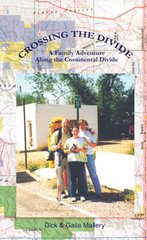Faith Garfield’s knees can’t take the stress of backpacking anymore. But the Santa Fe resident, now in her 60s, still hikes into places along the Continental Divide Trail in New Mexico to lop branches, shovel dirt and stack rocks on new sections of the trail. "This is a way I can be on the trail and give back to a place I love," Garfield said.
Her sons, avid backpackers in part because they camped with her as children, have hiked sections of the 3,100 mile CDT that Garfield helped build. She likes knowing her handiwork helped make their trek easier. "I personally like building new trail as opposed to maintaining an old one," she said. "You feel like a pioneer."
Garfield said she’s met a wide variety of people from all backgrounds in the last six years working on Continental Divide Trail projects. "It doesn’t matter who you are, you’re all there for one reason," she said. "People feel really good after they work a few days and then walk on a part of the trail they built."
Garfield is one of hundreds of volunteers who’ve spent days and weekends over the last decade working to complete the King of Trails as the CDT is affectionately known.
But the trail, stretching from the Mexican border to the Canadian border, along the West’s Rocky Mountain spine, is far from complete.
Congress designated the Continental Divide National Scenic Trail in 1978. About 70 percent of the trail is "useable," but many of the trail segments are in sad lack of repair, according to the Colorado-based Continental Divide Trail Alliance. Less then half of its 735-mile stretch through New Mexico is completed.
Problems with mapping an official route, funding, mixed land ownership and community opposition to the trail have challenged the trail’s completion.
Managing construction of the Continental Divide Trail fell in the lap of the U.S. Forest Service. And federal funding for the trail has been paltry.
The trail crosses through state, tribal, federal and private land in five states, creating a multitude of hoops the U.S. Forest Service must jump through to secure trail easements.
In Northern New Mexico, the proposed trail route also passes near or through traditional Hispanic land-grant territories.
Any trail building on federal land requires an analysis of the potential environmental and cultural impacts under the National Environmental Policy Act. Biologists, archaeologists and other field staff have to collect data. Their findings are analyzed and presented to the public. And the public voices its opinion about a trail’s route.
Pueblos and the Navajo Nation, for example, are concerned about where the CDT should go at Mount Taylor, a mountain considered sacred by tribes. The U.S. Forest Service has been negotiating with the tribes to find an acceptable route across the mountain without impacting traditional and cultural sites.
Ranchers are concerned about strangers passing across their land, leaving gates open, letting cows out and dumping trash.
For all the NEPA planning and field work, an estimated $40 million to $50 million is needed to complete the trail. Congress is currently haggling over a new federal budget. Meanwhile, federal agencies still are operating off last year’s money. That means an already low-priority like the Continental Divide Trail takes a further back seat to forest-thinning and forest-health projects.
Still, in fits and starts, the trail in New Mexico is getting built. When the alliance started in 1995, only 20 percent of the trail through New Mexico was finished. Now it is 46 percent complete. The New Mexico Mountain Club and the alliance have hand built 56 miles of trail over the last five years from outside the San Pedro Parks Wilderness near Cuba south to Mount Taylor, according to past club President Dave Jackson.
Jackson has hiked or worked on various sections of the trail. He considers New Mexico the toughest stretch of the CDT, both geographically and politically. Jackson said long stretches of the trail in New Mexico lack water. New Mexico Mountain Club members have at times trekked water into CDT hikers who had run out. Others rely on stock tanks.
The alliance and the Forest Service are focusing on holding community meetings in areas where the trail’s route remains undetermined, trying to explain the trail to residents.
Some towns are beginning to embrace the potential economic benefits of a completed trail. CDT hikers need to restock and rest up especially when they are doing big multi-day stretches of the trail.
Once completed, the Continental Divide Trail will be only the second trail, after the Pacific Crest Trail, across the U.S. from Canada to Mexico. It will be cause for celebration when the trail is finally finished.
Thursday, April 26, 2007
Subscribe to:
Post Comments (Atom)












No comments:
Post a Comment